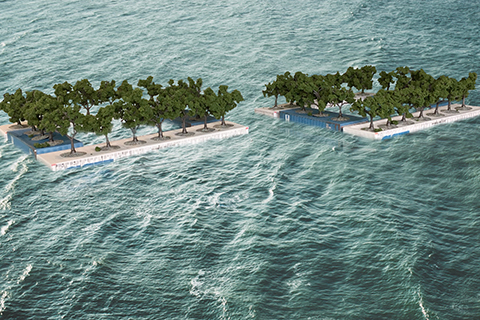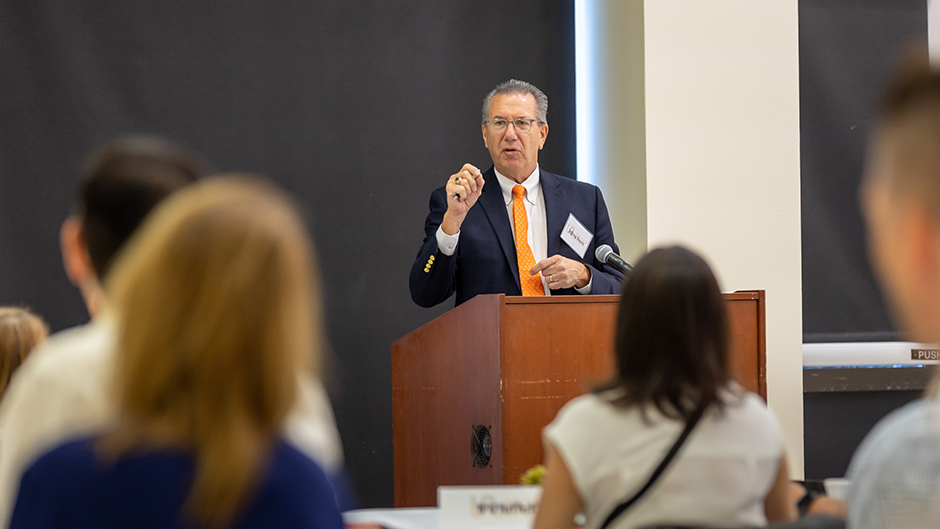The idea to create mangrove islands out of submerged shipping containers filled with recycled glass came to artist Billie Lynn while talking with members of her U-LINK team, who are on a quest to design new coastal protections that would not only be environmentally friendly but attractive, cost-effective, and structurally sound.
“It hit me when someone said we need to think outside the box,” the associate professor of sculpture recalled. “I thought, box? Shipping containers. I read there are enough to go to the moon and back because once they leak they can’t be used anymore so they are everywhere and are very inexpensive.”

That idea and many other collaborative proposals for resolving a myriad of complex problems were unveiled last week during a University of Miami Laboratory for Integrative Knowledge symposium that Susan Morgan, associate provost for research and U-LINK’s co-director, aptly called the “big reveal.’’ The daylong session at the Newman Alumni Center was, after all, the first time that the six multidisciplinary teams awarded the second round of U-LINK’s $40,000 Phase 1 grants in January shared their progress, which was considerable.
Most of the Phase I teams, which have diverse goals like the personalization of treatment for brain injuries, disruption of online conspiracy theories, elimination of built-in biases in the collection of big data, and the improvement of the wellbeing of children growing up in poverty, already have identified or applied for external funding to advance their research, which is the end goal of Phase II funding.
They’ve also forged partnerships with community stakeholders, surveyed thousands of people, conducted workshops, written papers, presented at conferences, taken field trips, assembled advisory boards, and, not least of all, seemingly met the primary Phase 1 goal of pulling experts from a multitude of disciplines into cohesive teams that can speak a common language.
“I would say they are making more progress than we hoped when we started this initiative in January 2016,” said U-LINK’s director, John Bixby, vice provost for research, who told the grantees that they are instrumental in keeping U-LINK on the path to continuous improvement. “We don’t think that this is a fully baked initiative yet and everything we hear from you all will help us shape how it works in the future.”
Provost Jeffrey Duerk, who supports U-LINK both philosophically and financially, had a big reveal of his own. Reflecting his belief that the team science approach must be fully integrated into the University’s research culture, he said Phase II teams will soon have the opportunity to teach undergraduate courses on their U-LINK projects.
The idea is not only to engage undergrads in solutions to intractable problems, but to create what Duerk called “a collection of individuals who can espouse the values of interdisciplinary collaboration.”
“This is the heart of what research will look like in the future,” the provost said, reminding the grantees that U-LINK is a key initiative of the University’s Roadmap to Our New Century strategic plan spearheaded by President Julio Frenk. “But it doesn’t begin and end with you. It is part of the Roadmap because this is where the University of Miami and all universities will be in the future.”
Members of all three of the inaugural five Phase I teams who were awarded Phase II funding of $150,000 a year for up to two years also reported considerable progress on their projects, all of which have particular relevance to Floridians. One is investigating how airborne toxins from algal blooms affect human health. Another is developing new hurricane forecast products to better communicate the risks and potential threats of approaching storms. The third is investigating hybrid artificial reefs to protect coastal communities from waves and storm surge.
During their own 20-minute progress reports, many Phase I team members acknowledged both the joys and challenges of becoming part of UM’s burgeoning team science culture. Lynn, who as an artist is accustomed to working alone, said she initially found it difficult but eventually invigorating to include the perspectives of an engineer, architect, economist, and ecologist in designing the next generation of seawalls and other coastal barriers that would be attractive to both sea critters and humans.
“I have learned more on this team than I probably have since I started teaching,” she said. “For instance, the financial part never occurred to me, but it’s all about money. Who has it, who’s going to pay, how the tax base will work to address these issues. That’s really key to how we are going to deal with these problems.”
And it is, in part, economics that is driving her idea for growing mangroves on top of discarded shipping containers, then deploying them offshore. As she notes, container islands could be a fast and cheap solution to protect property on Biscayne Bay, where, as a sailor, she knew the average depth to be about 9 feet—the exact height of a shipping container. Her team is also considering floating wetland mats and lacy biophilic concrete structures that, printed layer by layer on 3-D printers, could attract a range of sea life.
Like a lot of teams, graduate student Hannah Radabaugh said her “CaneBrains” team—which includes neuroscientists, computer scientists and a physician, psychologist, and health informatics expert—had to learn how to communicate before members could get down to the business of trying to combine biological and human factors with machine learning to personalize treatments for brain injury patients.
“We came across a lot of words that mean very different things to, say, computer scientists than they do to physicians,” Radabaugh said. “For example when you’re talking to a data scientist, ‘looking for regularities’ in the data means a very different thing than when a physician asks you if you’re regular. We had to take a step back and re-evaluate exactly what we were discussing.”

